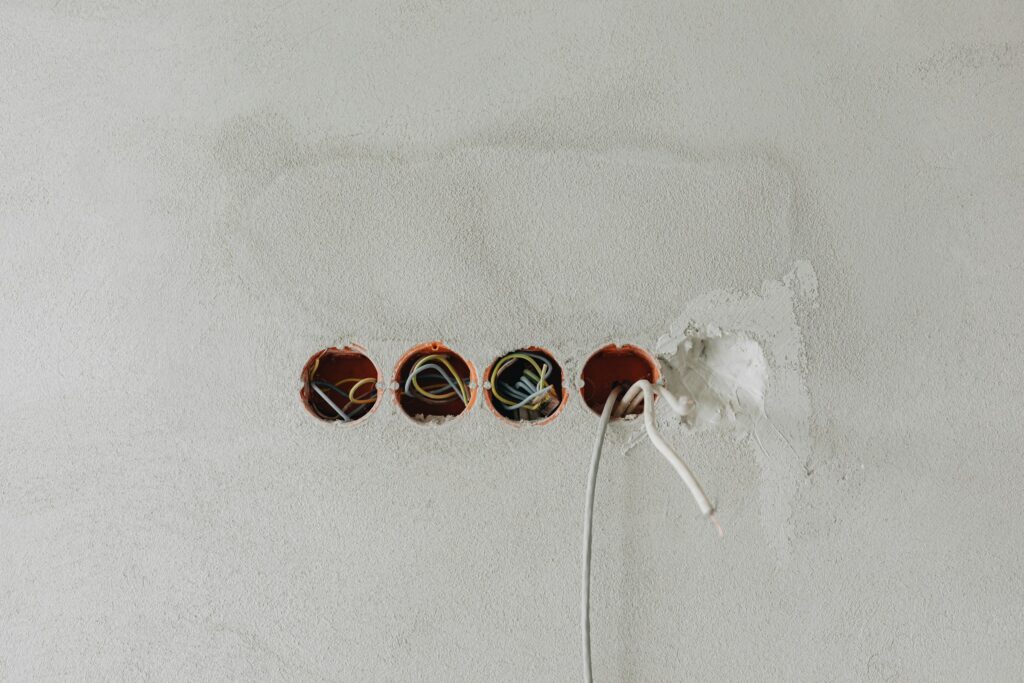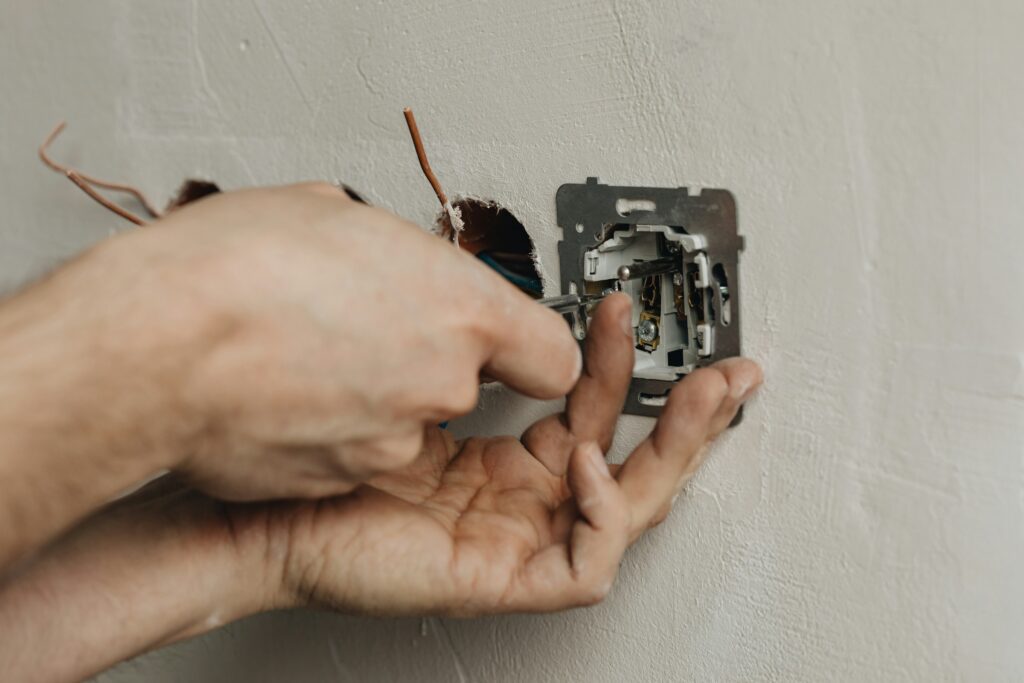Should You Consider Rewiring an Old House During a Renovation?
Renovating an older home comes with plenty of exciting opportunities, such as restoring original features, modernising spaces and adding your personal touch. However, one crucial aspect of renovations that’s often overlooked the state of the home’s electrical system.
Whilst rewiring might not be the first thing on your mind when you approach a renovation project, it can be a crucial step to ensure both safety and functionality. In this blog, we’ll explore the reasons why rewiring an old house during a renovation is often necessary, when it’s the best time to do it and the benefits it brings to your home.

Why might rewiring be necessary in an older home?
Older homes often come with charm, character and solid craftsmanship, but their electrical systems might not meet today’s safety standards or support modern living. Whilst rewiring isn’t always the most glamorous part of a renovation, it can be one of the most important.
Safety risks of outdated electrics
Old wiring can pose serious safety hazards. Overloaded circuits, crumbling insulation and poor earthing can all increase the risk of electric shocks, power cuts or electrical fires.
In some cases, you might find DIY electrical work from previous owners that doesn’t meet current regulations. A full rewire will ensure your home is not only safer, but fully compliant with modern standards. This is especially important if you’re planning to sell or rent the property in the future.
Common signs a house needs rewiring
There are a few tell-tale signs that a property’s electrics could be outdated or unsafe. These include:
- Frequent blown fuses or tripped circuit breakers
- Flickering or dimming lights
- Discoloured or scorched sockets and switches
- Buzzing noises from plug sockets
- A lack of sockets in each room
- Cables with fabric, rubber or lead insulation
If the property hasn’t been rewired in the last 25-30 years, it’s worth getting a qualified electrician to assess the system. They’ll be able to tell you if a full or partial rewire is needed and when it’s safest to carry it out.

What are the benefits of rewiring a house?
Rewiring an older property brings a range of benefits that go beyond safety. While the process can be disruptive, the advantages can often make it a worthwhile investment, particularly if you’re already renovating or modernising your home.
A full rewire will ensure your electrical system is safe, reliable and compliant with current regulations. It significantly reduces the risk of faults, shocks or fire hazards caused by outdated or overloaded wiring. For peace of mind alone, many homeowners find it’s a step worth taking.
Rewiring also gives you the chance to tailor the system to your lifestyle. You can add more plug sockets, reposition light switches, install USB outlets, or prepare for future additions like electric vehicle charging points or smart home features. It means your home will be more functional and better suited to the way you live.
From an efficiency perspective, a modern system can help reduce energy waste and support the use of energy-saving devices. Plus, if you’re thinking about selling the property in future, an up-to-date electrical installation can add value and reassure potential buyers.
When is the best time in a renovation to rewire?
The ideal time to rewire a house is during the major renovation work, particularly when floors, ceilings and walls are already being disturbed. Rewiring can be messy and invasive, so combining it with other building or decorating work can help to minimise disruption and reduce costs in the long run.
If you’re planning to renovate room by room, it’s worth tackling the electrical work early in the process, i.e. before plastering, painting or fitting new flooring. This will mean you should be able to avoid the need to undo finished work later on.
If you’re installing new internal doors as part of your renovation, it’s important to complete any rewiring beforehand. Electricians often need to run cables through or around door frames and doing so after new doors are fitted will risk damaging the finish.
Even if a full rewire isn’t needed, it might be a good time to upgrade the fuse board or install additional sockets, smart lighting or energy-efficient features, all of which are easier to do during wider renovation work.
What’s involved with rewiring a house?
Rewiring a house is a complex process that requires the expertise of a qualified electrician. The work typically involves removing outdated or faulty wiring and replacing it with modern cables and components that meet current safety standards, but the specifics will depend on what you want from your renovation and the current state of your property. Below is an overview of what the process will entail.
Initial assessment and planning
Before any work begins, an electrician will conduct a thorough assessment of the existing electrical system. They’ll evaluate the house’s layout, identify potential issues, and discuss your electrical needs based on the planned renovation. This stage is crucial for designing a system that’s both safe and tailored to your requirements.
Power down and preparation
Once planning is complete, the power will be shut off to ensure safety during the rewiring process. This involves isolating the circuits and preparing the space for the new wiring. Depending on the extent of the rewire, parts of the walls and ceilings might need to be opened up to access the existing cables.
Replacing old wiring
The old cables and wires will then be carefully removed, and new ones are then installed throughout the house. The electrician will run wiring for lighting, power sockets and any additional systems, such as data points or home security. They’ll also ensure that each part of the installation is correctly earthed and meets the necessary regulations.
Installing a new fuse board
The fuse board, or consumer unit, will be replaced with a modern version that can handle the electrical load of a modern household. This will ensure better protection against electrical faults and can help prevent overloading of circuits.
Testing and inspection
Once the rewiring is complete, the electrician will test the entire system to ensure everything works correctly and safely. This could include checking for faults, measuring continuity and verifying the correct operation of circuits. An inspection certificate will then be provided, confirming that the work meets legal requirements.
Finishing touches
Once the system is tested and approved, the final phase involves making any necessary repairs to walls, ceilings or floors that were disturbed during the installation. The electrician will ensure all sockets, switches and light fittings are securely installed, and the house is fully functional again.
Should you rewire the property during a renovation?
Rewiring an old house during a renovation may seem like a big task, but it’s often essential for both safety and functionality. Not only will it ensure your home is up to modern electrical standards, but it will also provide an opportunity to future-proof your property, enhancing its value and efficiency. By carefully planning to integrate the rewiring with other renovation works, you can minimise disruption and enjoy the long-term benefits of a safe, reliable electrical system.
JB Kind has a huge range of internal doors in a variety of styles, perfect for your renovation project. Download our brochure or contact us to find out more.